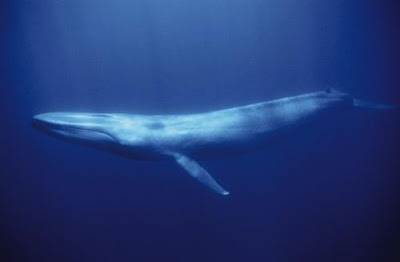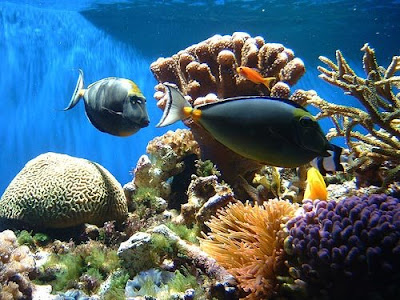Welcome to our marine blog! (:
Do browse through. And enjoy reading!
Please be patient as the background and song takes quite sometime to load(:
Navigations are on the left.






The World's oceans are home to countless species, from tiny plankton to the great whales. Exactly how large the proportion is still unknown. Many species are economically important to humans.
Marine life is a vast resource, providing food, medicine, and raw materials. The marine life also help to support recreation and tourism all over the world. Marine organisms contribute significantly to the oxygen cycle, and are involved in the regulation of the earth's climate.
Yet marine life, and the sea on which we depend, is under threat from pollution, over-fishing and other damaging activities. Therefore, this website is a reference to all individuals to know everything about marine life.
The content for this site are.
1)Introduction to Marine life
2)Examples of endangered marine species
3) What are the causes for the marine life to be endangered
4) What is Marine Conservation
5) Main Focus: Coral Reefs [Introduction]
6) Facts on Coral Reefs
7) Everything you have to know about Coral Reefs.
8)Factors affecting the growth of corals.
9) How important are Coral Reefs to us?
10) How are Coral Reefs threatened?
11) Marine Conservation Efforts in Other countries
12) Marine Conservation Efforts in Singapore
13)How can we, as an individual do our part to help to conserve the marine life.
14) IYOR 2008
15)Videos
16)Conclusion
17) Quiz
Labels: Introduction








Labels: What are the causes for the marine life to be endangered



Labels: What is Marine Conservation

Labels: Coral Reefs [Introduction]

Labels: Facts on Coral Reefs


1) Sunlight: Corals need to grow in shallow water where sunlight can reach them. Corals depend on the zooxanthellae (algae) that grow inside of them for oxygen and other things, and since this algae needs sunlight to survive, corals also need sunlight to survive.
2) Clear Water: Corals need clear water that lets sunlight through to survive. They don't grow well when the water is opaque as sunlight cannot reach them. Sediment and plankton can cloud water, which decreases the amount of sunlight that reaches the zooxanthellae.
3) Warm Water Temperature: Reef-building corals require warm water conditions to survive. Different corals living in different regions can withstand various temperature fluctuations.
4) Clean Water: Corals are sensitive to pollution and sediments. Sediments can settle on coral, blocking out sunlight. Pollution from sewage and fertilizers increase nutrient levels in the water, harming corals. When there are too many nutrients in the water, the ecological balance of the coral community is affected.
5) Saltwater: Corals need saltwater to survive and require a certain balance in the ratio of salt to water. This is why corals don't live in areas where rivers drain fresh water into the ocean.


Labels: How are Coral Reefs threatened?

Marine Conservation In Singapore
Singapore is a unique city in many ways. One of our strengths is that we are able to balance development with conservation. Although we are a densely populated city , we have managed to co-exist with an unusually rich biodiversity. 9% of our land area is devoted to green space and nature reserves, which in turn is home to more than 2,300 species of plants, 300 species of birds and a large variety of animals.
However, Singapore is at risk of losing a significant and unique constituent of the natural marine heritage. Land reclamation is one of the major contributors to marine degradation. Due to urbanization, Singapore reclaims land to accommodate its growing population and urban development, causing these marine creatures to lose their precious homes.

Another major cause of marine degradation is pollution from both commercial and consumer sources. Each year, Singaporeans use an estimated 2.5 billion plastic bags, which results in about 19 million kilograms of waste.
 Pulau Semakau is a good example of what we can do to conserve marine life in Singapore. Through careful management, Singapore have allowed a rich marine ecological system to thrive side-by-side with a landfill. Now, we can also boast of having a coral nursery close to the landfill. This is indeed an achievement that we can be proud of.
Pulau Semakau is a good example of what we can do to conserve marine life in Singapore. Through careful management, Singapore have allowed a rich marine ecological system to thrive side-by-side with a landfill. Now, we can also boast of having a coral nursery close to the landfill. This is indeed an achievement that we can be proud of.
The coral nursery is located underwater at a site off Pulau Semakau. This is a two-year project that aims to grow as many hard coral fragments as possible. Coral reefs will be grown to sufficient size and transplanted to coral reefs off the southern coast of Singapore to enhance the ecological health of these coral reef habitats.
This first coral nursery makes use of 'corals of opportunity' that are coral fragments damaged by some impact. Unlike commercial nurseries that make use of fragments deliberately broken off from healthy colonies, no healthy colonies will be used here. Breaking fragments off from healthy colonies poses a risk to the donor colonies.
Labels: Marine Conservation In Singapore
Labels: as an individual do our part to help to conserve the marine life, How can we


Labels: Conclusion